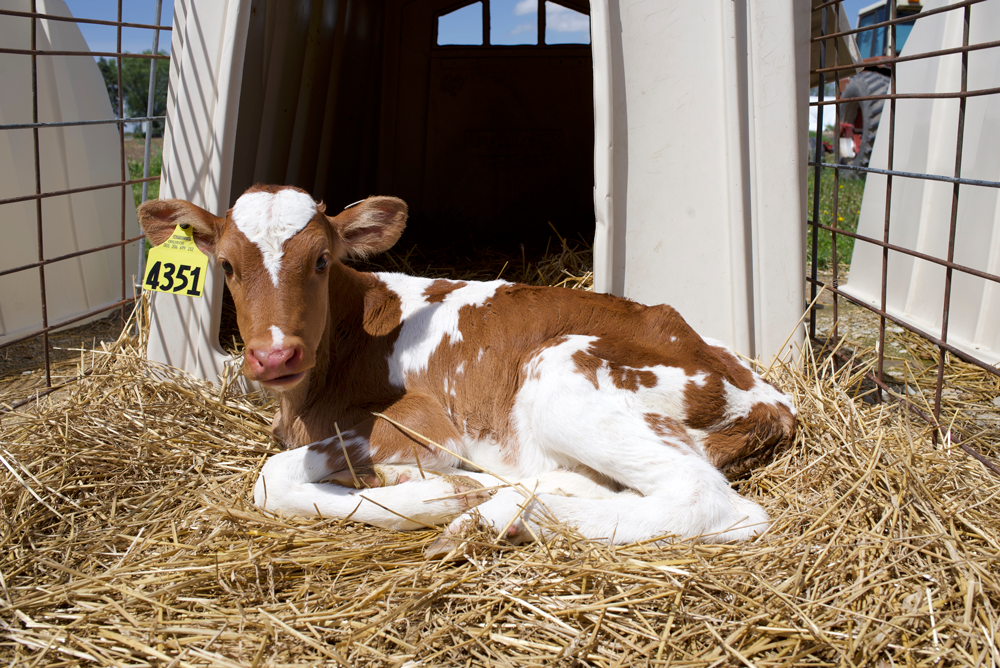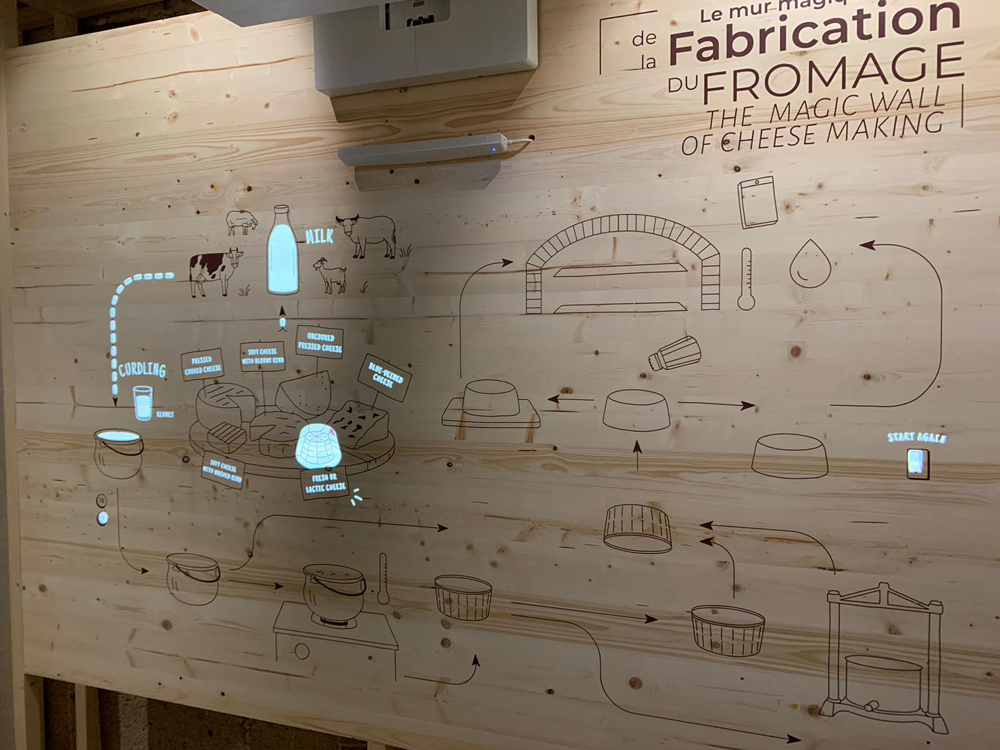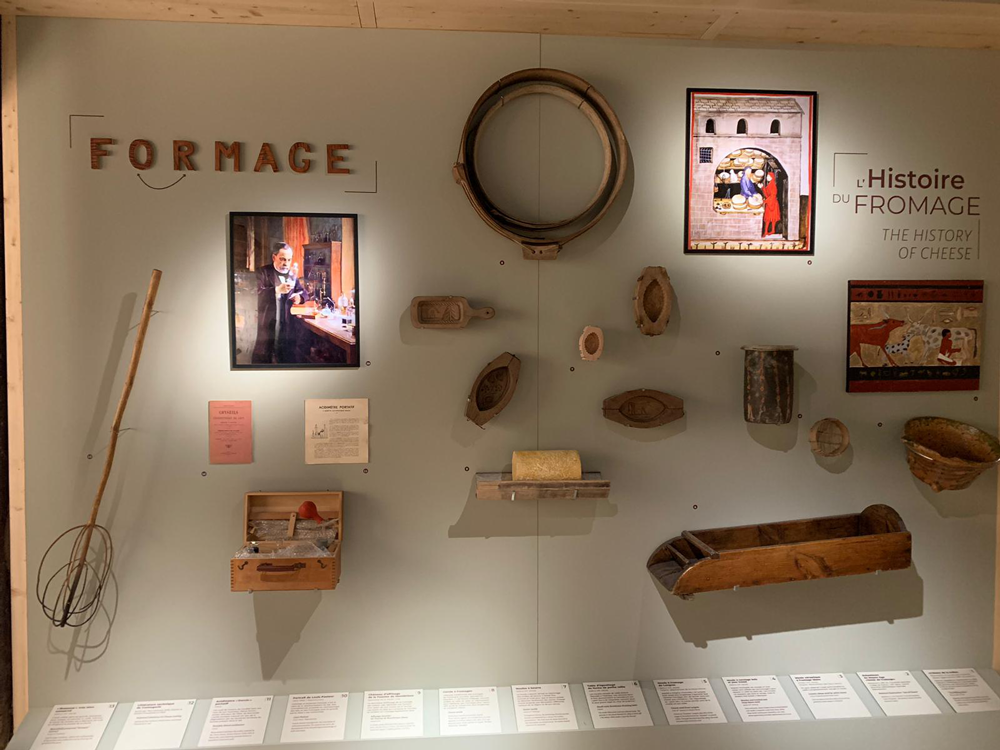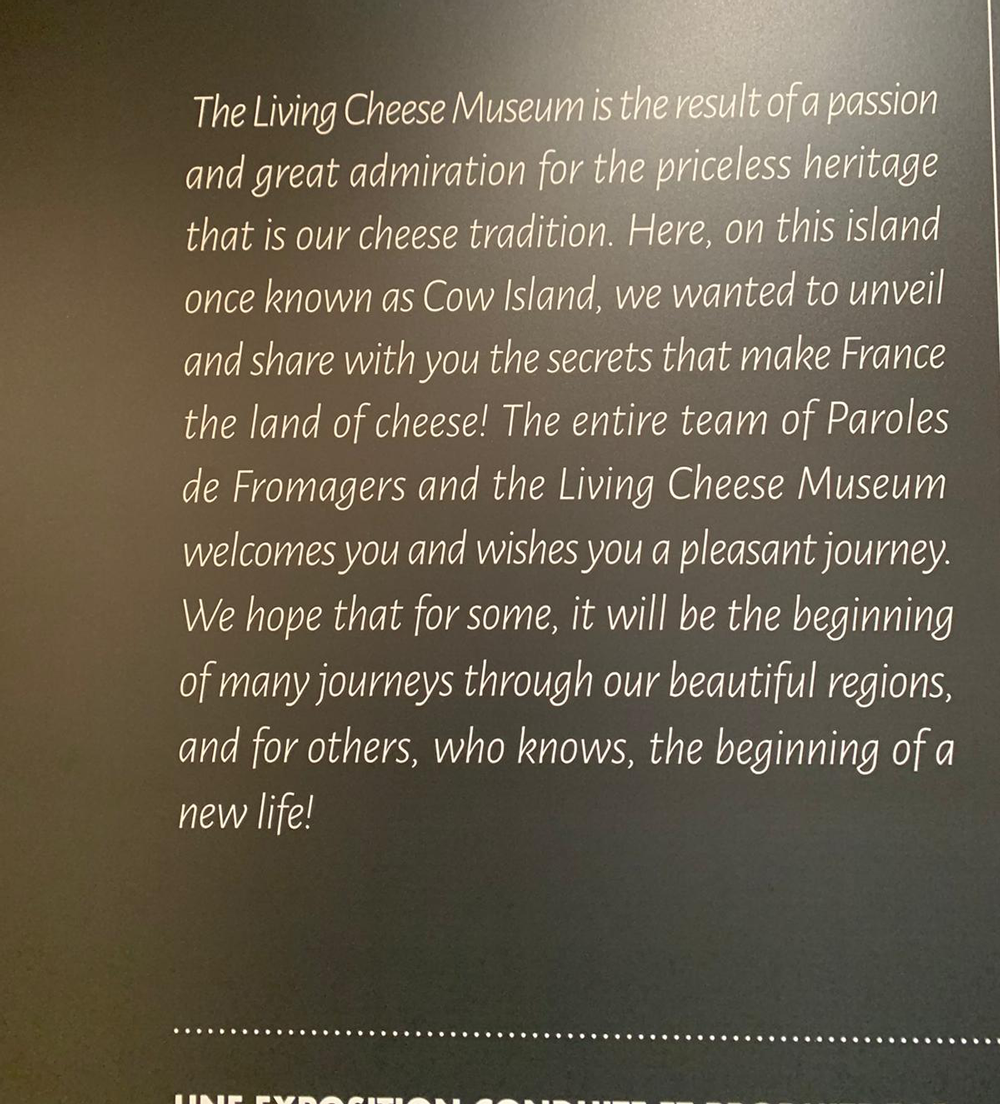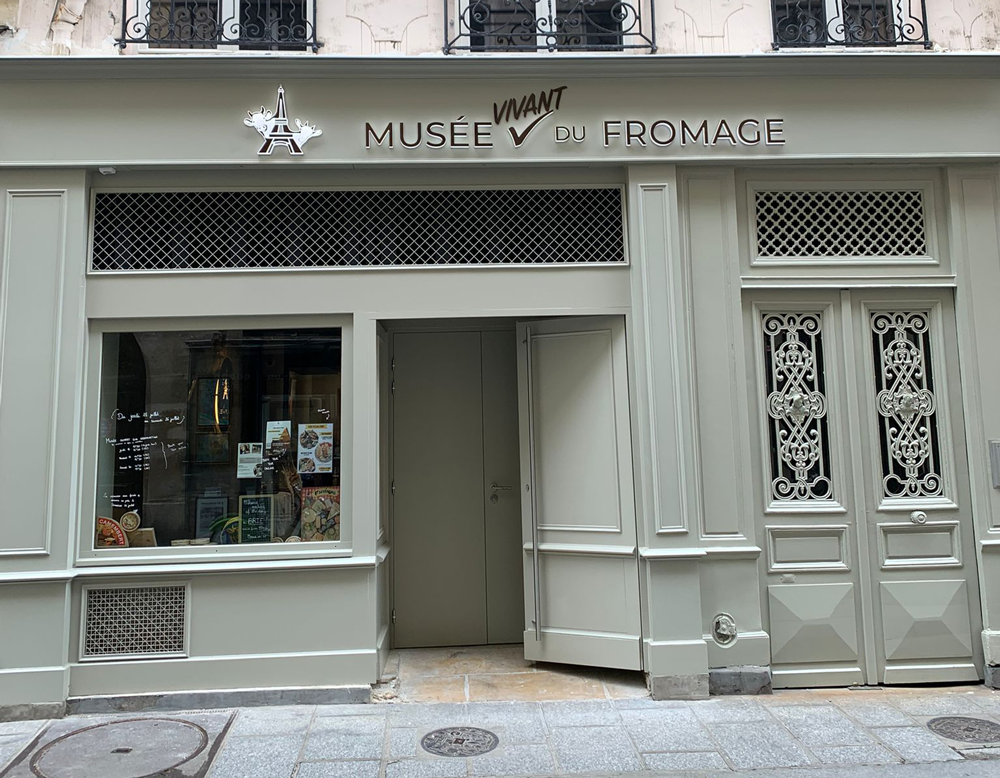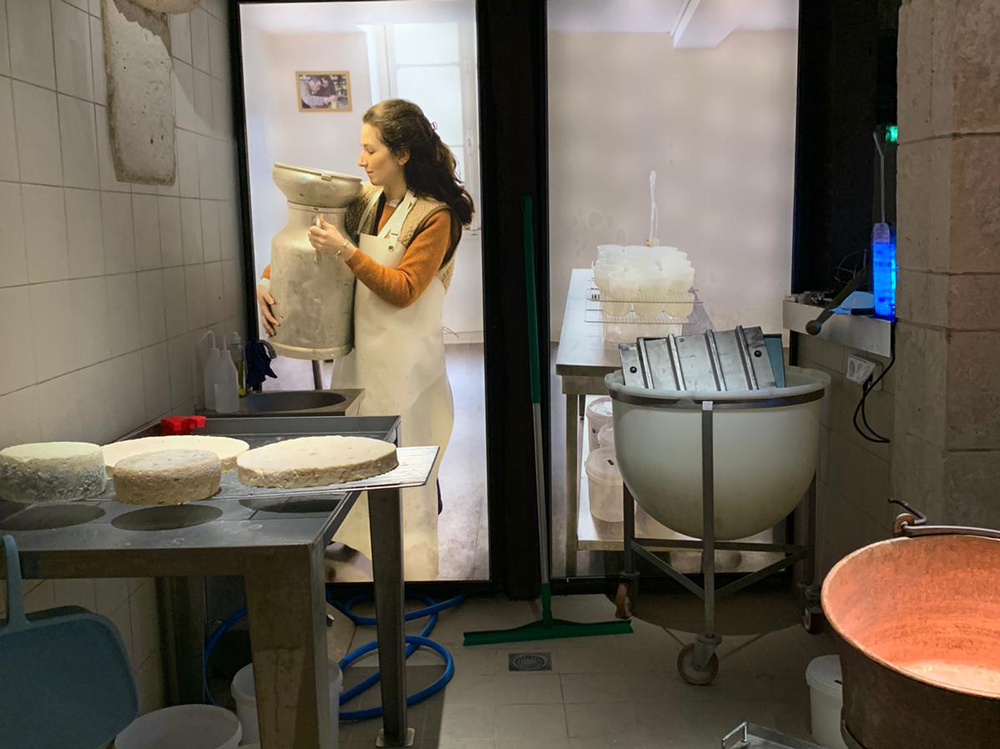Quiz time! Test your Guernsey cow knowledge: Hoard’s Dairyman Farm edition
Hoard’s Dairyman Farm (home to North America’s oldest continuously registered Guernsey herd) was established in _______.
a. 1850
b. 1912
c. 1987
d. 1899
Scroll past the image to find the answer!
If you guessed D.) 1899, you'd be right! The Hoard's Dairyman Farm was established by W.D. Hoard in 1899.
World Dairy Expo: “The industry meeting of the year.”
World Dairy Expo ran from October 1 to 4 in Madison, Wisconsin. As the world’s largest dairy-focused trade show, the exposition drew industry experts and enthusiasts from across the globe.
This year, the theme was “The Golden Age,” as in, the Golden Age of Hollywood. The era is famous for its introduction of sound and technicolor into movie-making. Think: The Wizard of Oz or Gone With the Wind; Grace Kelly, Marilyn Monroe, Humphrey Bogart… Clearly, “golden,” here, means “most iconic ever,” and that’s exactly why World Dairy Expo’s leaders chose it as the theme for their 2024 show.
“It feels so fitting,” said World Dairy Expo general manager Laura Herschleb on The Dairy Show podcast. “If you think about the Golden Age in film, that really referred to advancements and innovation. And advancements and innovation are what drive the dairy industry forward. There have been so many modernizations that have occurred over the last fifty years. We couldn’t think of a better theme that exemplified that.”
Rotary parlors, robotic milking systems, automated feeders – we certainly are in a new age of dairying, one W.D. Hoard doubtless dreamed of. The annual World Dairy Expo is at the helm of celebrating these achievements both big and small.
This year, the four-day spectacle included a trade show, cattle show, forage super bowls, youth contests, recognition awards, Career Connections, and contribution acknowledgements, all of which took place within the Alliant Energy Center grounds in Madison. There were approximately 50 industry expert presentations, 600 company booths, 3,000 international visitors from almost 100 different countries, and 2,500 of “the finest dairy cattle in the world.”
If those numbers seem impressive, consider this: in 2014, the expo saw a record-breaking 77,204 attendees.
“If you’re looking to expand your business and make connections, there’s no better place to be than World Dairy Expo,” said Herschleb. “Knowledge transfer happens so fluidly throughout the event. It’s like a melting pot – it’s like a family reunion from all over the world.”
No two shows are alike, and Herschleb says that’s intentional. The team is always looking to enhance the already-there metrics of excellence.
For instance, beginning 15 years ago, people could watch the events from afar by tuning into ExpoTV. This year, viewers were able to access a host of additional high-tech interactive elements by logging into ExpoTV.
For dairy farmers and everyone involved in the producer-to-consumer chain, Expo is like one big celebration of how far they’ve come and of what’s still out there to work towards.
“How lucky are we that we have this shared passion for the dairy industry and that we get to celebrate for ten days all together in one place?” said Herschleb. “It’s the industry meeting of the year.”
October 10th was W.D. Hoard Day
Pay tribute to the man who helped define the dairy industry by learning more of his story.
William D. Hoard
Hoard’s Dairyman Farm Creamery’s own W.D. Hoard was born on October 10, 1836. With this accordingly dubbed “W.D. Hoard Day” in our recent past, the time is right to take another look at the legendary leader who set the groundwork for the vision behind Hoard’s Dairyman Farm, Hoard’s Dairyman magazine, and the agricultural philosophies that define dairying today.
Even if you are in-and-out of the dairy world (in it just for the cheese – no shame), there’s a good chance you experience Hoard’s impact regularly. Any time you choose to consume a dairy product, you are interacting with the precedent for quality dairy farming that this man set over a century ago. His commitment to championing sustainable land, animal, and farmer practices permeates even the smallest bit of dairy consumption.
That basket of Wisconsin cheese curds? It was made possible by Hoard, who encouraged Wisconsin farmers to give up on wheat crops (failing year after year due to the area’s glaciated soil) and start investing in dairy cattle instead – a transition he’d seen succeed in his home state of New York. Every glass of milk, each bowl of ice cream, can be traced back to Hoard and his fellow early dairy visionaries.
Hoard was a musician, a politician, a war veteran, and a journalist all before becoming a farmer, but the agricultural wisdom instilled in him by his early employer and his friend Oneida Chief Thomas Cornelius remained a part of him all the while. His views on land management and cow care are the foundation for how dairy farmers in Wisconsin and beyond conduct their work today. Hoards’ Dairyman magazine – which Hoard himself began publishing as a supplemental reader to the Daily Jefferson County Union) — is sent to thousands of subscribers around the nation and world.
It’s worth noting that while William Dempster Hoard holds accolades untested for his work in the industry, he is not its progress’s sole proprietor. The Wisconsin Dairymen Association (of which Hoard was a member), Charles Rockwell, Anna Baldwin, Gail Borden, and many others also played a valuable role in America’s dairy development.
But by virtue of Hoard being a proponent of a kind of agriculture that preserved the land and the agricultural economy for years to come, he is ever-present in the high-quality dairying we see today.
Read a brief biography of W.D. Hoard here, and find your Hoard’s Dairyman Farm Creamery cheese favorites at www.hoardscreamery.com.
Quiz time! Test your Guernsey cow knowledge: Association Edition
The American Guernsey Association was originally called the __________.
a. American Guernsey Cattle Club
b. American Guernsey Advocates
c. Golden Guernseys Association
d. Americans for Guernseys Club
Scroll past the image to find the answer!
If you guessed A) American Guernsey Cattle Club, then you’d be right! Before the name was changed, the American Guernsey Association was known as the American Guernsey Cattle Club.
Sustainability isn’t just environmental
As companies take strides toward boosting their sustainability efforts, farmers are left with the responsibility of making the changes to their businesses.
W.D. Hoard believed that to produce high-quality dairy products, farmers had to invest in keeping their soil and animals happy and healthy.
Today, dairy farmers see to this by continuously researching and implementing a variety of environmentally friendly operational innovations.
Take feed additives, for one. The practice of including nutritional supplements in cows’ meals is a long-adopted practice. Guernseys at the Hoard’s Dairyman Farm are fed a total mixed ration (TMR) of corn silage, haylage, ground corn, protein mix, whey, vitamins, and minerals.
Lately, research has been surfacing about the possible benefits of adding a particular type of seaweed to cows’ rations. Asparagopsis may help reduce methane that is emitted during the digestive process of cattle, according to a study published in the Journal of Cleaner Production.
However, as Amy Bentley writes in an article published in Hoard’s Dairyman, the science behind seaweed additives is not absolute. In terms of its relevance to reducing methane emissions, 65% of dairy nutritionists at the 2022 and 2023 Cornell Nutrition Conferences in Syracuse, N.Y., believe it to be at least somewhat legitimate — a decent, while not assured, statistic.
Regardless, no amount of research or professional opinion for or against any given finding accounts for the actual groundwork of applying changes on a farm. That responsibility falls to the farmer, and farmers rely on the consistent output of their operation to continue running their business. If adaptation costs supersede daily undertakings, implementing the practice will not be financially sustainable for the farm.
“The risk of making big mistakes and losing a lot of money with some major changes or new types of machinery or innovative fertilizers and feed additives out of a knowledge-lack is very high,” said dairy farmer Florian Stummler in an interview with the Wall Street Journal.
“It also takes more steps and time to prepare the mixed ration with various additives,” Stummler continued, “as well as to plan the mating of the cows, which follows different, more detailed breeding objectives. And almost everywhere, the documentation effort has been increased or even been added to.”
The dialogue surrounding dairy’s ecological footprint is not solely about problem-solving, then. It is about meeting farmers where they’re at and understanding that truly sustainable dairying requires an approach that considers business, livelihood, and generation as much as it does climate and animal.
Mars and other companies have made a commitment to compensate their dairy farmers in alignment with the changes they are making, thus providing financial support for new and challenging undertakings. With continued implementation of programs like this, efforts to make the industry more sustainable will see greater success.
Our own Hoard’s Dairyman Farm Creamery cheese embodies W.D. Hoard’s commitment to well-rounded agriculture. Indulge rest-assured of the process by which it came to be.
How to consume cheese in autumn
(Yes, it’s possible to be doing it wrong.)
Nothing like some cheese and wine in that crisp, autumn air.
September is a month of harvesting, and, whether your at-home harvest is apples, raspberries, tomatoes, or seasonal home décor, odds are it would be enhanced by a snack pairing transcendent in its universal appeal.
How about, I don’t know, cheese?
What else checks as many boxes? Flavorful, textured, nutritious, diverse, global — cheese’s closest competitor is, perhaps, coffee, and even coffee is, sometimes, cheese.
Basically, if someone doesn’t go for cheese, they can’t be trusted (looking at you, Rachel from Hoyme Hall floor three).
Dairy Farmers of Wisconsin recommends highlighting cheeses that are savory, aged, and nutty during the autumn months. These three deceivingly broad flavor profiles, when paired with seasonal sweater weather foods, act as bridges connecting the snacks’ strengths and contrasts.
For instance, a smooth Gouda would pair well with candied pecans, an aged Cheddar might compliment a freshly picked apple (try Honeycrisp or Pink Lady), and a creamy Butterkase cheese may be your red grape vine’s best friend.
Feeling adventurous? Plan a trailblazing cheese pie for your upcoming Friendsgiving, or sign up for a fall-themed charcuterie board class, offered around the country. (Yes, there are legitimate paid courses meant to teach hopeless aesthetic arrangement folks like myself how to present cheese and meat in a manner worthy of an Instagram reel.)
For guaranteed palate satisfaction, check out Hoard’s Dairyman Farm Creamery’s selection of cheeses, linked accordingly above. And be sure to share your personal recipe and pairing findings with us.
Here’s to hoping for cooler days to come, and for occasions that welcome experiments in cheese tasting (as if I need an excuse).
Quiz time! Test your Guernsey cow knowledge: US debut edition
The Guernsey cow breed made its U.S. debut in ______.
a. 1912
b. 2010
c. 1840
d. 1818
Scroll past the image to find the answer!
If you guessed C. 1840, then you know your Guernseys! The Guernsey cow breed made its U.S. debut in 1840.
A founder after fondue’s own heart
The man behind France’s first cheese museum shares his expertise about the history and singularity of French cheese.
Scheduling an interview across time zones is easier said than done. Scheduling an interview across time zones with someone who is the official cheese and wine tasting supervisor of the summer 2024 Paris Olympics — well, forget it.
But if there’s one thing Musée du fromage’s Pierre Brisson will always make time for, it’s cheese: serving it, talking about it, making it — his life revolves around the product, and that includes carving time out for an interview with a burgeoning dairy expert (me).
When I spoke to Brisson, it was over a 12 a.m. Central Standard Time video call. Brisson came into the frame with a wide grin; he was enjoying a brisk, sun-filled morning in the garden of his home outside of Paris.
Within the first twenty seconds of bon soir’s and bonjour’s, I knew him to be a man of singular enthusiasm. He spoke of cheese the way one might hail their pure-blooded Labrador or tout a Yale-bound nephew. He spoke of cheese as if it were the most delightful part of his life. And, lucky for us, it is.
Brisson began his French cuisine quest as a vigneron, or winemaker, and later developed an affinity for cheesemaking. Upon entering the field, he noticed a gap in public education about the cheesemaking craft, specifically about French cheese’s storied history and regional departures.
Because France is so unique a country in that it contains a myriad of climates (oceanic, continental, mountain, and Mediterranean), the kind of cheeses that are produced from north to south and east to west are magnificently varied.
“The diversity of climates was a challenge for early cheesemakers,” Brisson said. “But it made possible many different kinds, the kinds we have today.”
Musée du fromage (France’s first-ever museum dedicated to the history and making of French cheese, created and run by Brisson) details this early cheesemaking trial and error in its exhibition room.
It all started with fifth-century monasteries. The monks needed a substitute for contraband meat — something that provided comparable nutrition. Curdled milk, with its high protein content, became a popular alternative.
“They recorded their recipes for cheese in documents passed between monasteries,” Brisson said. He has visited some of these monasteries himself. “In the original documents, you can see that the type of cheese depended on the ideal way to make it in the different climates where the monks lived.”
For instance, he continued, “In a flat region, where people could travel easily, it was ideal to make and sell wet cheese. They could sell the strained water, too. In the mountains, where travel is difficult, it made sense to strain the curd and make a hard cheese, which would preserve well.”
Brisson and Musée du fromage honor these early French cheesemakers by showcasing cheese that is made by producers who have the craft’s integrity and the product’s purity in mind.
The combined efforts of educators like Brisson and farmers like the ones whose cheese occupies a tray at the museum mean a future for the profession that sees continued respect for over 500 years of artisanship.
See the result of this history-making museum’s launch for yourself on the (once pasture-covered and thus “Cow Island” dubbed) Île Saint-Louis in le coeur de Paris, or opt for ordering equally lauded American-made cheese at www.hoardscreamery.com.
France’s first cheese museum puts producers in center stage
At Paris’s Musee du fromage, locals and foreigners can learn about the unique history and varieties of French cheese.
Steps from the Notre Dame cathedral, on land once lauded for its graze-friendly grasses, le Musée du fromage stands as a living lighthouse for the future, adorned in vision and bejeweled by layers of the past.
As France’s first and only museum dedicated to cheese and cheesemaking, Musée du fromage — newborn to the city of love — has its work cut out for it. But if there’s one thing Parisians (nay, everyone) loves, it’s tastefully curated curd, and that’s exactly what Musée du fromage celebrates. Its mission is not only to educate the public about French cheese and its history, but, too, to champion the livelihood of dairy producers across the country.
Museum owner and cheese and wine expert Pierre Brisson sees this attraction’s inception as an opportunity rich with purpose.
“I want to bring the love and understanding of cheese to the public,” Brisson said. “I want people to leave [the museum] thinking about France’s incredible regions and the producers and farmers who live there.”
France is already well known for its cuisine — de la ratatouille et du vin de Bordeaux, anyone? — but little is known about the diversity and particulars of its cheese.
The country contains quite a unique confluence of climates: oceanic, Mediterranean, mountain, and continental. Each provides singular environmental conditions under which food may be prepared, so, by nature of existing under these distinct conditions, French cheese possesses a wide variety of tastes and textures simply by being the product of vastly differing regions.
This fact is highlighted in the museum’s exhibition room, which includes a wall-borne history of how French cheese, in all its variants, came to be. Also included in this space is an interactive screen upon which one may take a quiz determining “what kind of cheese they are.”
Following the exhibition is a small but functional creamery where visitors can view cheesemakers at work in real time, every day of the week. Then, guests are led by their guide to a cheese tasting room, where a variety of French cheese awaits topping a culinary favorites list.
The tour also includes information on over 300 French dairy producers, including farm locations, so guests may further their learning. Ideally, for Brisson, the museum and its encouragement of continued dairy education will inspire a whole new generation of cheesemakers.
“I want people to leave the experience thinking, ‘Now I want to make cheese,’” he said. “There isn’t a lot of advertisement about the profession.”
But why? There are multitudinous national education efforts about French wine. Wineries themselves invite guests to visit their grounds and taste test on-site.
For dairy producers, Brisson said. It’s different. Farmers aren’t likely to invite tourists directly to their farm because animal care and land cultivation has to be carefully monitored and protected. One’s operation is under the inherent risk of whoever is there at any given time, so it carries that producers don’t play host.
This is why a museum like the one Brisson has built from scratch is so important: It provides a window where there isn’t one. It acts as binoculars into the world of dairy farming and cheesemakers, while encouraging further support and appreciation for the people and animals who bring milk and cheese to the table.
If you find yourself in Paris, pay the place a visit. If it’s anything like my globe-trotting sister described it to be on her stop along the Olympic spectator way, you won’t be disappointed.
In the meantime, check out Hoard’s Dairyman Farm Creamery’s selection. It may not be French, but it stands the test of excellence.
Summer has the monopoly on dairy appreciation
Frozen yogurt
For those of us who live in a region defined by its seasons, there is no better time of the year to indulge in all things dairy than summer.
Chilled smoothies, iced coffees, frosted milkshakes, ice cream cones, ice cream sundaes, ice cream sandwiches, ice cream cakes…beastly hot days call for beastly good snacks.
And if the heat weren’t incentive enough to consume double the food group for three months out of the year, June is National Dairy Month, June 4 is National Cheese Day, July is National Ice Cream Month, and August is National Goat Cheese Month.
I’m convinced: I have to stop for frozen yogurt on the way home. The national calendar catalog says so!
But with August’s end just around the corner and the beckoning of autumn a song in spreading breezes, is it too late to pay homage to the summer-dominating industry that is dairy? We think not.
Dairy products are just about everywhere, and they’re ready at hand to enhance a late summer gathering.
Hoard’s Dairyman Farm Creamery’s selection of pure Guernsey milk cheeses pay tribute to, as W.D. Hoard put it, the foster mother of the human race. If you’re looking for all-around quality cheese board staples, look no further.
If mixed milk cheeses are your thing, search for creameries in your area whose curd comes from cow, sheep, and goat milks. Some creameries, such as LaClare Creamery in Malone, Wis., specialize in goat milk products, making them a perfect destination for the August’s chèvre theme.
Looking to improve your morning cold brew with additional health benefits? Top the glass off with a splash of value-added milk. Not only will it mean less digestive upset for lactose-intolerant folks, but it may get you closer to your protein goals.
Eager for a bowl of traditional, slow-churned ice cream? Take a last-minute summer vacay to Cincinnati, Ohio, home of Graeter’s Ice Cream, to experience the dessert at its finest. Or, you can order your favorite flavor from their online store.
Dairy comes in all shapes and sizes, and it is nutritionally sound every day of the year. But while the food industry spotlight is on the cow and her cousins, let us celebrate what goes into making that cheese board possible. Let us nod to the farmers and makers around the world who make monstrously hot months like these more bearable.
Who knows? Maybe one day there will be a National Butter and Sour Cream month. With dairy, the possibilities are endless.







